AR tools for industrial maintenance
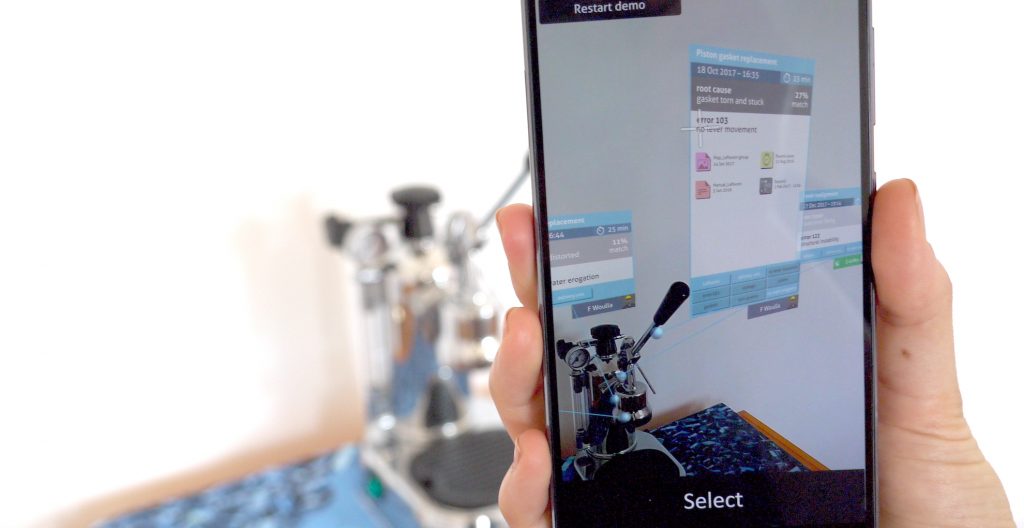
AR tools for industrial maintenance Hitachi Share Experientia created digital AR tools that added intelligence and efficiency to the industrial maintenance and repair processes in the shopfloor’s context. A working hi-fi AR prototype was demonstrated to the C-suite. Based on the as-is maintenance process and existing pain points, Experientia conceptualized use-case scenarios, interaction flows and interfaces. 3 things to know Express delivery Our benchmark focused extensively on Europe, US, China and Japan while industry experts joined our research from 5 different countries, bringing insights from all around the world. Focus on core issues Through user journey mapping, main issues of industrial maintenance were uncovered and turned to key solutions for the interaction concept. Innovation throughout Cutting edge technology platforms like AR Core and Google’s Cloud Speech API were used to create a coherent system between mobile, smartwatch and earbuds. Gallery Multilayer tech ecosystem that combines three devices: smartphone, smartwatch and headphones Watch interface Watch interface Analysis diagram of the maintenance process and existing pain points In depth Service mix: Prototyping Information architecture Service design Behavioral modeling Context The client is an industrial player that has its own factories and also provides shop floor equipment to factories of their clients. In these environments any interruption in an assembly or production line is very costly. Challenge Efficient production time is lost due to misinformed, miscommunicated and non-standardized maintenance processes. The solution is a combination of user and system generated content that constantly improves according to daily incoming data about maintenance operations. The client would like to use AI and machine learning to provide values for all the stakeholders. Research Focused on worker’s needs to get jobs done rather than just spreading technologies, our solution was built on day-to-day tech providing maintainers with non-invasive support enabling them to be able to choose the best tech and device depending on the context and their personal experience. We used a (high end) coffee machine as a simulacrum of an industrial machine and mapped user journey and defined opportunities of digital tools for industrial maintenance. Design The proposed solution is a multilayer tech ecosystem that combines three devices: smartphone, smartwatch and headphones. They overlay timely, qualitative and statistical information to maintainers about assets, manuals and maintenance steps. The solution enables communication amongst colleagues and creates an easy reporting system, all integrated through a user and system generated database. Experientia designed a hi-fi prototype to showcase functionality and adequacy of an augmented multistep maintenance process on an exemplary machine. The prototype consists of an augmented reality app on mobile, an information app on a smartwatch and voice assistant interaction on a bluetooth headset. The demo across three devices proved interaction patterns and its benefits. The user journey consists of the six steps of a general maintenance process (asset failure, location, inspection, repair, spare parts, report and shift handover) organized along with macro phases (inspection, operation, communication, documentation). As second layer, we considered elements such as actors / tools and challenges and we highlighted the time consuming activities. Impact The client used the demo internally as a proof of concept to obtain further funding for future exploration As next steps the knowledge platform needs to be implemented and the solution should be tested on a shopfloor.. Related projects All Services Behavioral design Research and assessment Strategy B2B Collaboration UI, redesigning the filter navigation experience B2B Reinventing customer and supplier interactions for a multinational flooring company B2B Driving digital transformation one touch at a time Go back to our portfolio
Innovation opportunities in the Polyclinic of Palermo
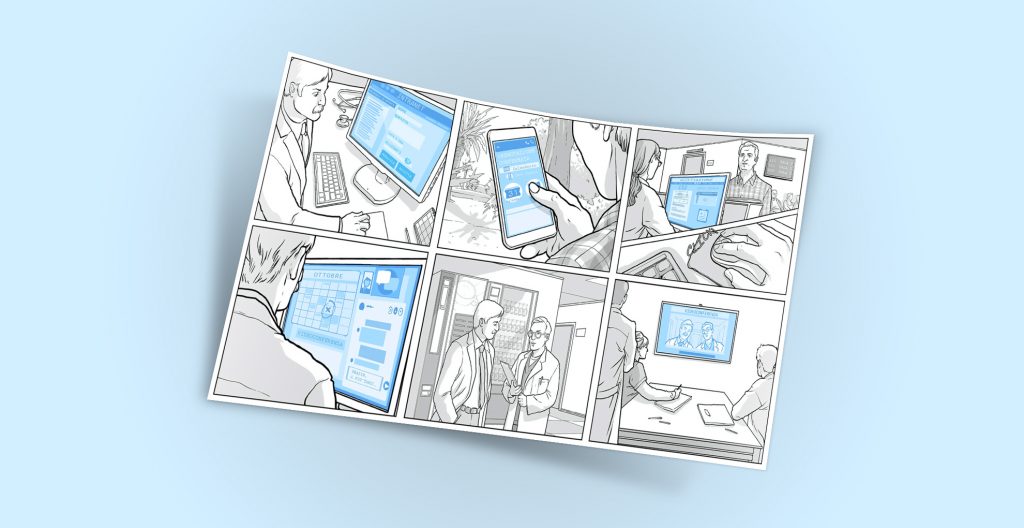
Innovation opportunities in the Polyclinic of Palermo Policlinico Giaccone Share Understanding the user experience in the hospital to bring incremental innovations to its clinic services 3 things to know Flexibility and adaptation An iterative approach throughout the project allowed us to adapt the analysis on the hospital context, its rules, and emerging unexpected opportunities. Observe, understand, create bridges Understanding behaviors and expectations of users, doctors and professionals was essential to respect the equilibrium between different perspectives in the hospital context. Deliver innovation pills Experientia proposed small solutions that could have a great impact on users (patients and HCPs) and that could be more easily integrated into the complex system of a University Hospital. Gallery In depth Service mix: Prototyping Participatory design Service design Behavioral modeling Ethnography Challenge We carried out a user centered design project within the University Hospital Polyclinic Paolo Giaccone of Palermo with the aim of generating innovative ideas to be deployed in its clinics in the area of cardiology, oncology, opthalmology and haematology. Following a participatory process, we involved the clinics’ medical staff in research and generative activities, detected two concepts and prototyped one of them. Research We conducted contextual interviews and shadowing for one week in 5 clinics in the Polyclinic, with physicians and nurses, their heads, and other primary actors in the clinic under study (e.g. postgraduate doctors, psychologists and administrative staff). This research allowed us to understand the functioning of the complex hospital system in the specific context of outpatient visits, aiming to propose solutions benefitting both HCPs and patients. Design Based on the workshop results, two design concepts were presented, one focused on effective communication between health professionals and the other on the welcoming and orientation of the patient. Considering the boundaries of the project, we decided to further develop the first concept, to illustrate it with a use scenario, and to integrate with a high level prototype aimed at showing functionalities of the main hospital software that could be implemented in order to facilitate interdepartmental communication. Impact The solution aims at facilitating collaboration – both between healthcare professionals within the same ward, and with other hospital facilities – through the optimization and integration of the functions of the Hospital Intranet and the creation of opportunities for meetings between healthcare professionals. Related projects All Services Behavioral design Research and assessment Strategy Health GoCare: Interactive dashboard for a better home hospitalization service Health Rare disease patient journey mapping HealthSocial innovation Singapore: a city for people aging gracefully Go back to our portfolio
Low2No: shaping the future of sustainable living
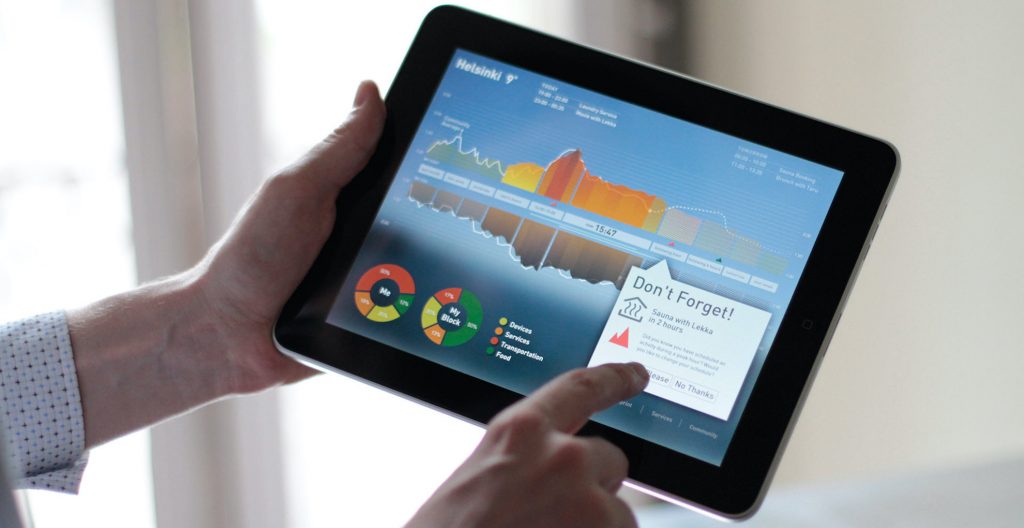
Low2No: shaping the future of sustainable living Sitra, the Finnish Innovation Fund Share In the former container port area of Helsinki, a building block named Airut (“messenger” or “herald” in Finnish) has risen to showcase innovative solutions for green developments worldwide. In collaboration with the engineering firm Arup, the architect studio Sauerbruch Hutton and Galley Eco Capital, Experientia has been a key contributor of this mixed-use development block, which houses around 500 residents, together with small-carbon-footprint services. 3 things to know Creating value through service design We designed energy demand management solutions and services and coordinated “mixed use” service offerings. The core of the service was enabling participatory solutions, such as games, competitions, workshops and websites for all its users. Behavioral change We analyzed drivers of behavioral change like environmental & life constraints, motivation and belief, social pressure and constraints, cultural framework, architectural and interface affordances, and designed fifty initial ideas for tools and services to facilitate behavioral change in Jätkäsaari Award winning Airut and Low2No have already won two awards – the 2011 Italian national prize for innovation in services and an acknowledgement prize in the 2011 Holcim awards for sustainable construction. Gallery In depth Service mix: Prototyping Information architecture Participatory design Service design Ethnography Useful links: Italian National Prize for Innovation in Services Blog post 2011 Holcim awards for sustainable construction Blog post Context The climate crisis requires new ways of designing and living our built environment, particularly in colder countries like Finland. Sitra, the Finnish innovation agency, launched an international competition for a low carbon housing and commercial building complex in Jätkäsaari, a reclaimed goods harbour to the west of central Helsinki, that aims to facilitate behavioural change towards more sustainable lifestyles. Challenge The competition was won in September 2009 by an international team led by global design, engineering and planning firm, Arup, providing engineering and sustainability services. The team also included Berlin-based Sauerbruch Hutton as lead architects and consumer behavior-change strategists Experientia. The building complex covers 22,000 square metres and provides new residences, office and retail space. Emissions are reduced through building design and performance, mobility systems and food production Research As the experience design partner, Experientia’s role has been to nudge the behavior of the people that visit, live and work at Airut, in a lasting sustainable direction. This nudge is being achieved through actively involving potential future residents and entrepreneurs in the development of their future environments, through the design of impactful, sophisticated and sustainable service offerings, and through the creation of behavioral change programmes. Design These interventions help to reduce energy demand and carbon emissions by enabling residents and workers to make better choices about their consumption while enjoying a very high quality of life. They are, in other words, “soft infrastructure” offerings that will complement the block’s “hard infrastructure” for energy and carbon management, including geothermal preheating and cooling, building integrated photovoltaics and a carbon neutral bio-heat product provided by the district heating network. Our specific deliverables have included a behavioral change framework, an award-winning service platform design, and a smart meter user interface design. Experientia has also worked on the planning and design of services, to create, within the Low2No project, a “Food Hub” (offering services related to the purchase, consumption and sharing of regional, organic food, an ethical and sustainable alternative to the products commonly offered in the Finnish market); an “Eco-laundry” (using highly efficient practices and detergents with a low environmental impact); and a communal, wood-fuelled sauna (an eco-friendly response to the presence of a private electric sauna in most Finnish homes). Impact Construction has been completed and the block is now occupied. From now, the sustainable ideals that govern its day-to-day life act as a model and example for the rest of Helsinki, Finland and the world. It has already won two awards – the 2011 Italian national prize for innovation in services (awarded to Experientia), and an acknowledgement prize in the prestigious 2011 Holcim awards for sustainable construction (awarded to the full design team). italian National Prize for Innovation in Services Blog post 2011 holcim awards for sustainable construction Blog post Related projects All Services Behavioral design Research and assessment Strategy Cities & InfrastructureSocial innovation ToNite: social innovation and urban regeneration in Turin, Italy Social innovation Turin Public Libraries, redesigning the cultural experience Social innovation COE, Strengthening access to justice through non-judicial redress mechanisms Go back to our portfolio
XME Pay: redefining an m-payments ecosystem
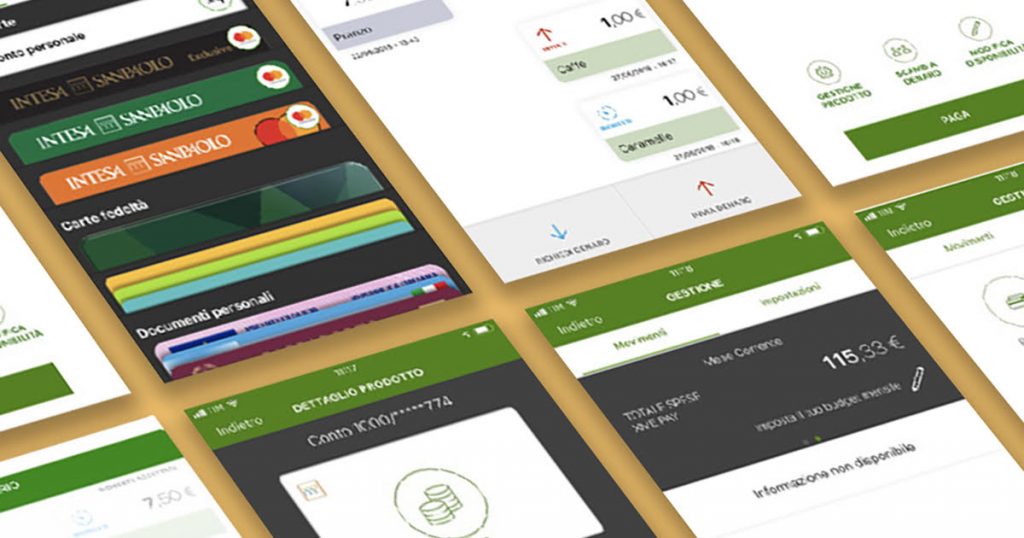
XME Pay: redefining an m-payments ecosystem Intesa Sanpaolo bank Share The human-centered approach is now central to the finance industry, as banks have become savvy in how to best connect to their customers’ needs and desires. As part of this trend, Intesa Sanpaolo asked Experientia to collaborate in the ideation and development of innovative features for a payment app (XME Pay). 3 things to know A step forward for digital and mobile payments The app is designed to be simple and immediately usable by a wide range of users. It also provides new services and functionalities, to improve on existing solutions. Working in agile mode To make development faster, we experimented with hybrid modes of prototyping, UX/UI design and agile methodologies. This helped ensure an efficient process and technically feasible solutions: concepts translate insights into actionable innovation opportunities to be prioritized, prototyped and evaluated. They took the form of platform or service visualizations, product design sketches, feature ideas, interaction and user interface solutions. Ongoing checks with service users To speed up the process of prototype testing and design iterations, we carried out several test rounds (with young users, seniors, professionals and families). Gallery In depth Service mix: Prototyping Information architecture User experience testing Behavioral modeling Useful links: Link to XME Pay Service by ISP Context Mobile and contactless payments continue to grow at an astonishing rate in Italy. In this context, Intesa Sanpaolo needed to quickly develop an effective mobile solution, able to compete both with the solutions provided by the main market players (Apple, Google) and with new innovative local players (SatisPay). Challenge Experientia was asked for a support during the contextual research, the definition of service concepts and prototypes, and the usability tests. Research Experientia conducted 16 contextual interviews in Milan and Naples, 10 with end-users and 6 with merchants. The interviews allowed us to identify payment behaviors and routines, and to generate ideas for accessory services such as discount management and loyalty cards. Design The study of the concept features was fundamental in the definition of the first and subsequent prototypes. Working in Agile, it was possible to quickly carry out several iterations of the application, and to test the functions with users in special sessions: some were dedicated to usability testing (training evaluation), others to specific insights, with different solutions in comparison (A/B testing). Impact The final solution was then developed and released in the summer of 2018, and was adopted in the first six months by 1.2 million customers (18% of the bank’s multi-channel customers). Link to XME Pay Service by ISP Related projects All Services Behavioral design Research and assessment Strategy Finance Banca 5, a new branchless bank model Consumer technologyFinance BancoSmart, an award-winning ATM Finance CSA: sentiment-based decision support platform for crypto-currency trading Go back to our portfolio
XME Salute: integrating insurance offerings with wellness and health practices
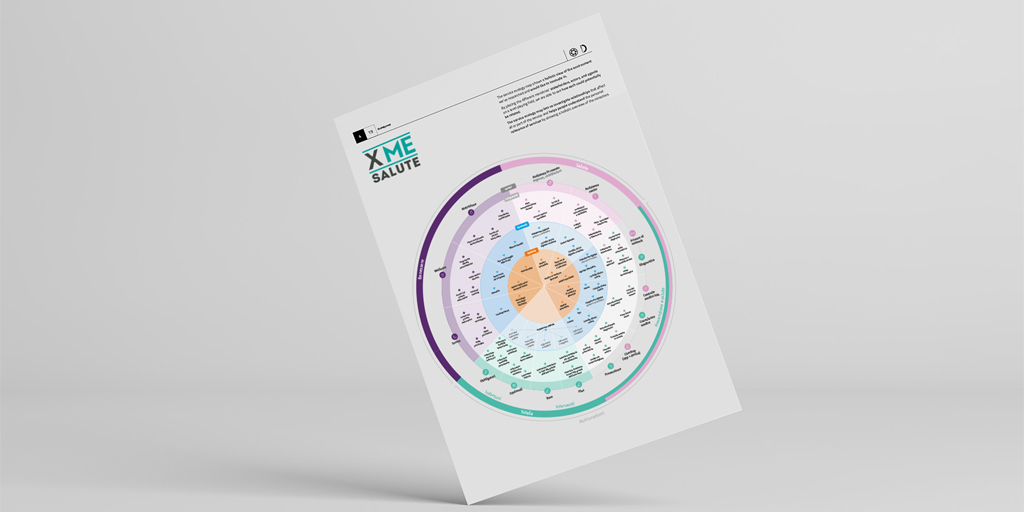
XME Salute: integrating insurance offerings with wellness and health practices Intesa Sanpaolo bank Share Analysis of the areas of overlap between welfare practices and insurance offering, up to the realization of a banking product able to enhance them both. 3 things to know Redefine the meaning of “insurance product” Research results allowed us to identify behavioral patterns regarding the attribution of value and meaning in health and wellbeing areas, and define hypothetical use scenarios on how to involve users in a holistic self-care. Facilitating and enabling behavioral change Based on an analysis of the offer and on the formative evaluation, we were able to create a better definition of the service model and a detailing of pre-requirements to convey this service through digital/web and mobile platforms. Drivers of behavioral change We analyzed drivers of behavioral change such as Environmental & Life Constraints, Motivation and Belief, Social Pressure and Constraints, Cultural Frameworks, and Architectural and Interface Affordances. Gallery In depth Service mix: Prototyping Information architecture User experience testing Behavioral modeling Useful links: Link to XME Salute Service by ISP Context Since the middle of the last decade, the phenomenon of private healthcare insurance in Italy has increased regularly: in 2016, 10 million Italians declared that they had private healthcare insurance, and the reason for the choice is due to a fundamental reason that prevails over everything else: the length of waiting lists (72.6%). To deal with a context in which users give up medical treatment because it is too expensive, Intesa Sanpaolo has launched an innovative service, able to integrate wellness practices (e.g. improving nutrition, sleep, …) with easy access to a network of clinics in which to book online medical examinations, diagnostic tests, dental and physiotherapy services. Challenge The Intesa Sanpaolo Innovation Center turned to Experientia for ongoing support in defining value propositions for its new set of services, called XME Salute (“Health 4 me”). We investigated behaviours, values and convictions people have on themes such as wellness, health and their relation with insurance products. Research Research results allowed us to identify some behavioral patterns regarding the attribution of value and meaning among health and wellbeing areas, enabling us to create hypothetical use scenarios to understand how to involve users in a holistic self-care. We analyzed drivers of behavioral change such as Environmental & life constraints, Motivation and belief, Social pressure and constraints, Cultural framework, Architectural and interface affordances. Design Based on the offer and the formative evaluation, we were able to better define the service model and detail some pre-requirements in order to convey this service through digital/web and mobile platforms. Impact Health services are an important testbed for the cultural change required by digital, so it is essential that the service model provided remains consistent with the initial design: for this reason, since the launch of the service (June 2019) we have continued to follow the evolution of features in order to keep them consistent with the service model. Link to XME Salute Service by ISP Related projects All Services Behavioral design Research and assessment Strategy Consumer technology Buttonless: engaging users in interactions with keyless devices B2B Collaboration UI, redesigning the filter navigation experience Cities & InfrastructureSocial innovation ToNite: social innovation and urban regeneration in Turin, Italy Go back to our portfolio
EZY Crowd Go, easy crowd guidance optimization
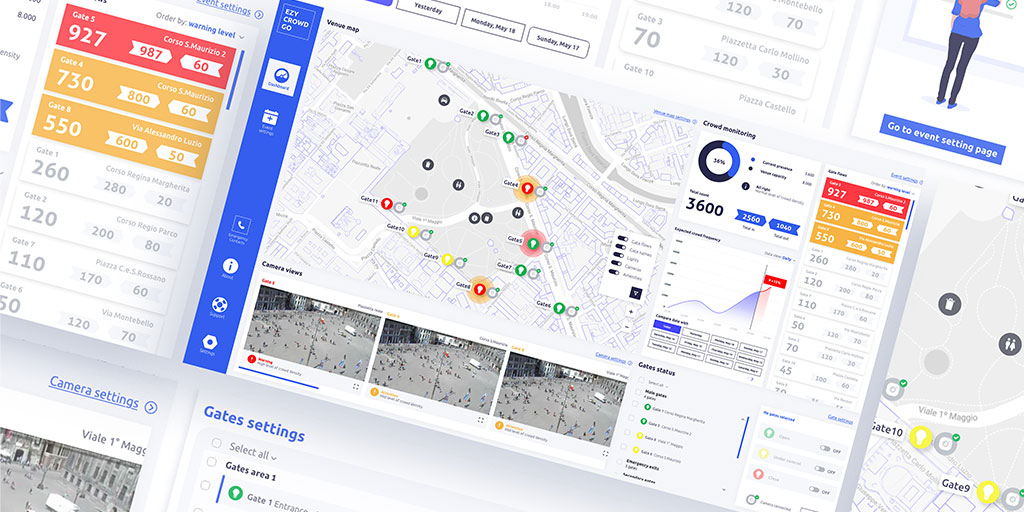
EZY Crowd Go, easy crowd guidance optimization EIT Digital Innovation Factory, European Research Project Share As a partner of the EZY – Crowd Go (an EIT funded project), Experientia co-designed wayfinding solutions to guide crowds during temporary events in public spaces. We conducted stakeholder research and led co-design activities with event managers and security professionals to identify new service opportunities, provide UX guidelines and design the prototype of the IoT dashboard. 3 things to know Clarify the needs and “jobs to be done” Investigate start-up MVP market interviewing stakeholders involved in the event management industry, to clarify needs, pain points and opportunities regarding the management and monitoring of crowds. Define the value proposition Using co-design methodology to identify a long term USP for safe exit strategies during temporary events. Future customers are both public authorities and private organizations that would benefit from using a system that guides event-goers to the least crowded exits. Design and validate the MVP solution Defining UX strategy and guidelines for visitor front-end exit guidance and designing a hi-fi dashboard prototype of the operational lights and sensors back-end IoT. Gallery In depth Service mix: Envisioning Prototyping Service design Context In the context of the European research project EIT (European Institute of Technology) Digital, Experientia co-designed wayfinding solutions to guide crowds during temporary events in public spaces. The IoT solution combines non-invasive WiFi crowd monitoring and crowd guidance directions using smart lights and sensors. Challenge During the initial and exploratory phase, we conducted stakeholder research and led co-design activities with event managers and security professionals to identify new service opportunities. During the design phase, we defined UX guidelines and designed a dashboard IoT prototype for security and facility managers to recommend behavior choices based on a data analysis of crowd-behavior. Research During the “early bird period” November-December 2019 Experientia research team conducted in-person and remote stakeholder interviews. The in-depth interviews allowed us to investigate the research question from a broad, comprehensive perspective. The main objective of the research was to investigate and identify opportunities for temporary event management. Model At the beginning of 2020 Experientia conducted a kick-off workshop with all the partners . We shared insights from the stakeholder and user research phase to inform and define the value proposition. Through participatory and co-design methodologies we facilitated the development of the next phases as well as conducted concept ideation activities. Design Experientia and the Polytechnic University of Milan used the findings from research to frame and define solutions for the design phase.In particular, we define the design guidelines for effective and inclusive crowd guidance and developed three innovative concept for addressing crowds during temporary events. Moreover, our interaction team design and validate the HI-fi prototype of the centralized dashboard, aim to collect crowd data and help operator make decisions and set the light system. Related projects All Services Behavioral design Research and assessment Strategy Cities & InfrastructureSocial innovation ToNite: social innovation and urban regeneration in Turin, Italy Social innovation Turin Public Libraries, redesigning the cultural experience Social innovation COE, Strengthening access to justice through non-judicial redress mechanisms Go back to our portfolio
CityOpt: Engaging citizens to facilitate energy demand responses
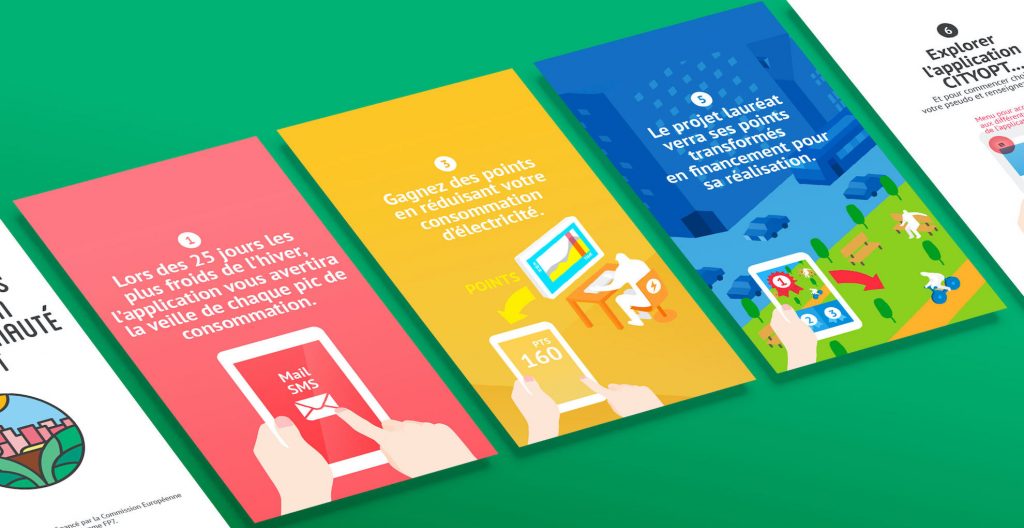
CityOpt: Engaging citizens to facilitate energy demand responses European Commission FP7 Share CityOpt, a research project funded under the FP7 European Commission framework, is getting citizens involved in testing new tools to reduce energy consumption during peak loads, with the goal that this pilot program will set a new trend in protecting locations with fragile electricity supplies. 3 things to know Encouraging behavioral change The CityOpt app helps people reduce domestic energy consumption during energy peak loads and nudges them towards more eco-friendly behaviors. Incentivizing energy reduction Their savings were rewarded with points, which participants could “donate” to a local community project of their choice, helping to maintain people’s engagement with the app. Real time monitoring An office block in Vienna, Austria, uses the CITYOPT app to identify the best scenario to integrate energy supply sources with fluctuating temperatures into an efficient micro-energy network.. Gallery In depth Service mix: Policy development Envisioning Business strategy design Prototyping Information architecture Participatory design Service design User experience testing Context One of France’s most fragile regions, the Provence-Alpes-Côte d’Azur, is perhaps best known for its vineyards, lavender groves and sparkling coastal cities like Nice. It is however also one of France’s most fragile regions for electricity supply. Particularly in winter, when electrical heating sees electricity use rise, the locals experience frequent blackouts, as the local energy provider, EDF, tries to manage the supply. This is why Nice Côte d’Azur has been selected as a pilot city for the CITYOPT project, an initiative that aims to create new methods and tools to deal with energy consumption, and to involve local citizens in designing and testing them. CITYOPT is a pilot programme funded by the European Commission that explores and tests new tools for reducing energy consumption during peak loads. Research Experientia has led the user research activities for the pilot program. User experience methodologies have engaged local citizens from the area in interviews, workshops and design activities. These have defined what people really need to help them control their energy use, and to create a mobile app that the pilot participants will be able to use to do just that. The entire project has applied a user experience (UX) methodology, to make sure that the tools and methods that the project proposes for energy management resonate with the people who will have to use them. It’s not just Nice Côte d’Azur: other pilots are planned for Helsinki, Finland and Vienna, Austria, where similar UX methods are also being applied. Right now, the Nice pilot looks at the residential level, and explores how people’s everyday behaviors can be nudged to better support the energy use of the entire region. Model Changing individual behaviors to help the entire region The Nice Côte d’Azur local population plays a crucial role in reducing domestic electricity consumption during peak loads. To help people change the way they consume electricity, the pilot provides selected locals with the CITYOPT mobile app (aka the CITYOPT Operational tool). The app informs people about upcoming network peak loads, and then uses playful persuasion to get them to commit to lowering their energy consumption at a specific time. How the app was created – a participatory process The Experientia design team also focused on the visual design of the mobile application. In workshops for design idea creation, designers and local stakeholders came together to brainstorm innovative ideas that could potentially be included in the app. A second participatory workshop, again involving local stakeholders, compared these ideas to the expectations and needs of local people, which had been uncovered in the original interviews and workshops with people from the region. The feasibility of the different ideas was discussed, and the final features for the CITYOPT app were selected. Designing, sketching and coding is a long road from ideas to app. First Experientia’s design team, with the support of the local project partners, worked on three wireframes of the app, which defined the information architecture and interaction model for how the app would work. Later on, colors and styles were added, taking it from outline to a fully-fledged design. Experientia then developed the front-end, web-based code, while the consortium partners – CSTB and EDF – implemented the back-end, repositories, hardware interfaces and statistical algorithms. Nice Côte d’Azur Métropole was responsible for localizing the application in French and recruiting local dwellers to participate in the pilot test. Impact The project was piloted with 200 households in Nice using the CITYOPT app during the first wave of testing. During the demonstration test, leader Experientia explored how people use the app, whether they take part in the demand-response scenarios, and what conditions and driving factors are most likely to convince people to participate. The test research was supported by quantitative and qualitative activities like online surveys, contextual interviews and contextual observations. The actual consumption data was also measured through pre-installed smart-meters, and used to evaluate the effectiveness of the CITYOPT system. The CITYOPT project has provided us with real data on effective ways to convince people to reduce their energy use at a level that can help improve the consumption of an entire region. It’s now a matter of scaling up the project to the entire region, and beyond, and providing a body of information that can be used by any region looking for effective ways to reduce energy use. Meanwhile, the other CITYOPT pilot programmes will demonstrate that Nice is not a solitary example, and that user experience methodology can offer real impact on people’s behaviors, and on behavioral change for more sustainable lifestyles. Related projects All Services Behavioral design Research and assessment Strategy Cities & InfrastructureSocial innovation ToNite: social innovation and urban regeneration in Turin, Italy Cities & InfrastructureSocial innovation Low2No: shaping the future of sustainable living Go back to our portfolio
CSA: sentiment-based decision support platform for crypto-currency trading
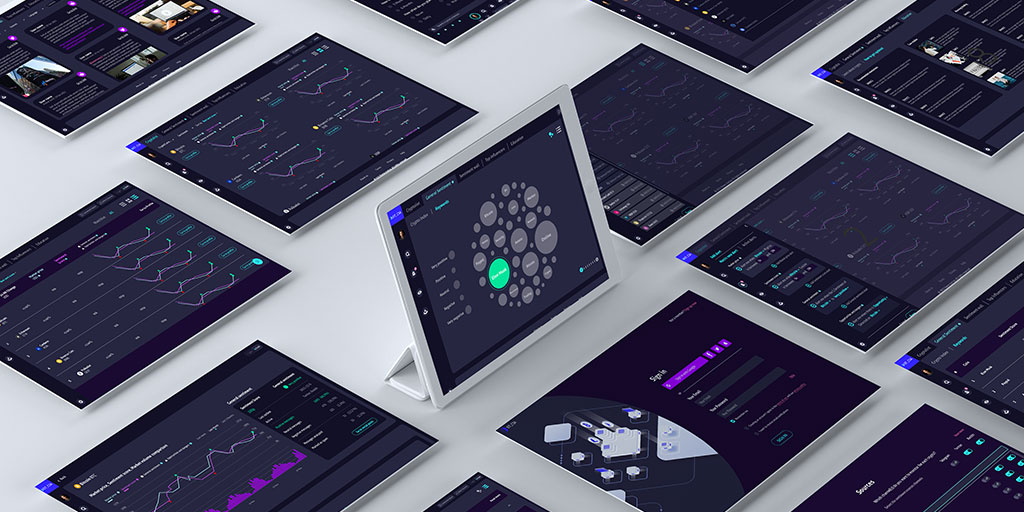
CSA, Sentiment-based decision support Platform for crypto-currency trading EIT Digital, European Research Project Share As a partner of the CSA-Crypto Sentiment Advisor (an EIT research project), Experientia co-designed a web-based dashboard to inform better decisions in the crypto market. Leveraging traders’ individual level of expertise, the solution aims to mitigate risk by using real-time community sentiment data. 3 things to know Understand the habits of cryptotraders By interviewing cryptotrading experts and cryptotraders with different levels of experience, we were able to understand their habits, their sources of information, and the web platforms currently most used by those who invest in cryptocurrencies. Define the value proposition Using co-design methodology we worked with other project partners to identify a USP and the platform’s MVP: a dashboard to inform better decisions in the crypto market by using real-time community sentiment data. Design and validate the MVP solution Based on the results of the research and the co-design work done with the project partners, we designed the UX/UI of the platform, validated it with user interviews, and defined web development specifications. Gallery In depth Service mix: Design thinking Prototyping Information architecture Participatory design Ethnography Context As a partner of the CSA-Crypto Sentiment Advisor (an EIT research project), Experientia co-designed a web-based dashboard to inform better decisions in the crypto market. Leveraging traders’ individual level of expertise, the solution aims to mitigate risk by using real-time community sentiment data. Challenge The platform is based on a sentiment analysis model for cryptocurrency using advanced machine learning methods. Investors can use the signals to manage volatile phases of their portfolio to be well positioned in difficult times. During the research phase, Experientia conducted research interviews with lead users and led co-design activities with project partners to identify the Value proposition and the MVP functionalities. In the design phase, we designed the dashboard prototype and validated it with potential users. Research During the “early bird period” November-December 2020 Experientia research team conducted remote stakeholder interviews. The in-depth interviews allowed us to investigate the research question from a broad, comprehensive perspective. The main objective of the research was to investigate and identify opportunities for helping cryptotraders with sentiment-analysis tool. Model At the beginning of 2021 Experientia conducted 2 workshop with all the partners. We shared insights from the stakeholders and user research phase to inform and define the value proposition. Through participatory and co-design methodologies we facilitated the development of the next phases as well as conducted UX concept ideation activities. Design Experientia utilized findings from research to frame and define solutions for the design phase. In particular we design and validate the HI-fi prototype of the Sentiment-based decision support Platform for crypto-trading. Related projects All Services Behavioral design Research and assessment Strategy Finance Banca 5, a new branchless bank model Consumer technologyFinance BancoSmart, an award-winning ATM FinanceHealth XME Salute: integrating insurance offerings with wellness and health practices Go back to our portfolio
Turin Public Libraries, redesigning the cultural experience
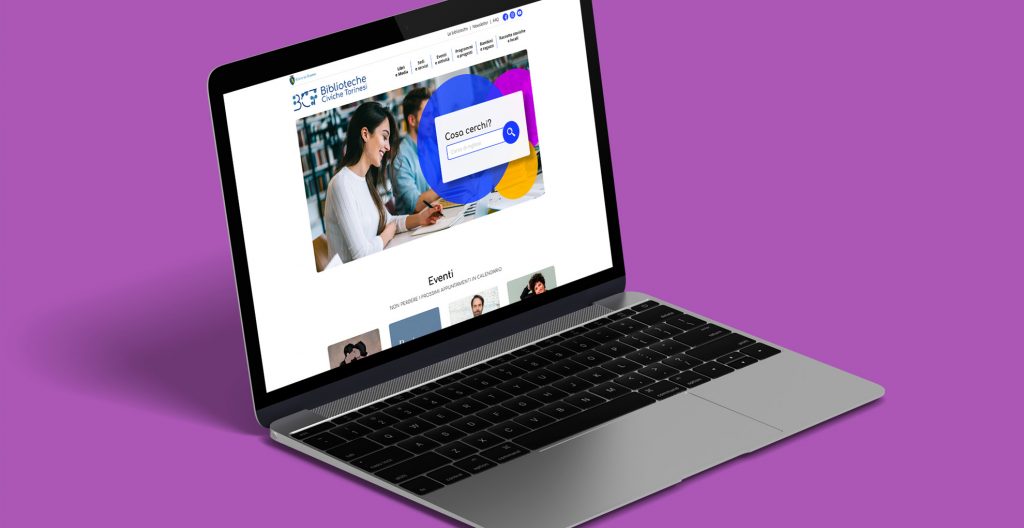
Turin Public Libraries, redesigning the cultural experience CSI Piemonte Share CSI Piemonte partnered with Experientia to redesign the new digital experience for Turin public libraries: an ecosystem of more that 15 local libraries spread across the Turin area. Weekly design thinking workshops and co-creation activities with the local libraries team allowed us to gather all the different perspectives of a complex reality diversified among the territory. 3 things to know One website, more that 15 local libraries The website of the Turin public libraries (“Biblioteche Civiche Torino”) gathers all the information connected to more that 15 local libraries spread across the territory. Every library has its own audience, events, reading proposals, services and articles. Library directors highlighted the importance of each library: every user sticks to his neighborhood library rather than being a frequent visitor to all libraries. For this reason, creating sub-homepages for each library was important to support users in their usual behavior using the service. Design thinking workshops Design thinking methodology was applied in order to achieve a final website that was cohesive and could meet all the different needs among the complex and diversified contexts of the territory. Weekly meetings with the librarys’ selected tea allowed a step by step approach and the possibility to validate each part of the website with the stakeholder in charge of that service: events, programs and projects, children section, historical and local collections. A piece of an ecosystem The website is a part of a complex ecosystem composed of a catalog online and a digital lending platform. The two services (catalog and digital lending) are not located within the Turin public library website but instead in different domains. These three platforms have to recall each other’s contents and give the perception of a solid ecosystem. Information architecture methodology and content organization were necessary in order not to lose any pieces during product integrations. Gallery In depth Service mix: Prototyping Information architecture Participatory design Useful links: Biblioteche civiche torinesi External link Context The Turin Public library website had to be updated in terms of information architecture and prioritization of informations, as well as visual presence and new look and feel. The portal is the final stage of the “Rethinking Turin Civic Libraries” project, launched in 2019 on the occasion of the 150th anniversary of the founding of the Central Civic Library and supported by Intesa Sanpaolo. Research An extensive desk research allowed the team to spot best practices and common design patterns used by the most important library websites. A detailed content audit was necessary to be sure that each information of the “old” website would have been revised during the redesign. Weekly meetings with stakeholders and two specific workshops (directors of local libraries and kids&teens audience) were the key stages to came out with important insights that led the design choices. Design The redesign of the website was supported by information architecture and wireframes activities. The responsive website is designed with a mobile first approach and uses common design patterns, usability rules and accessibility. See here for the final outcome of the project. Biblioteche civiche torinesi External link Related projects All Services Behavioral design Research and assessment Strategy Cities & InfrastructureSocial innovation ToNite: social innovation and urban regeneration in Turin, Italy Social innovation COE, Strengthening access to justice through non-judicial redress mechanisms HealthSocial innovation Singapore: a city for people aging gracefully Go back to our portfolio
GoCare: Interactive dashboard for a better home hospitalization service
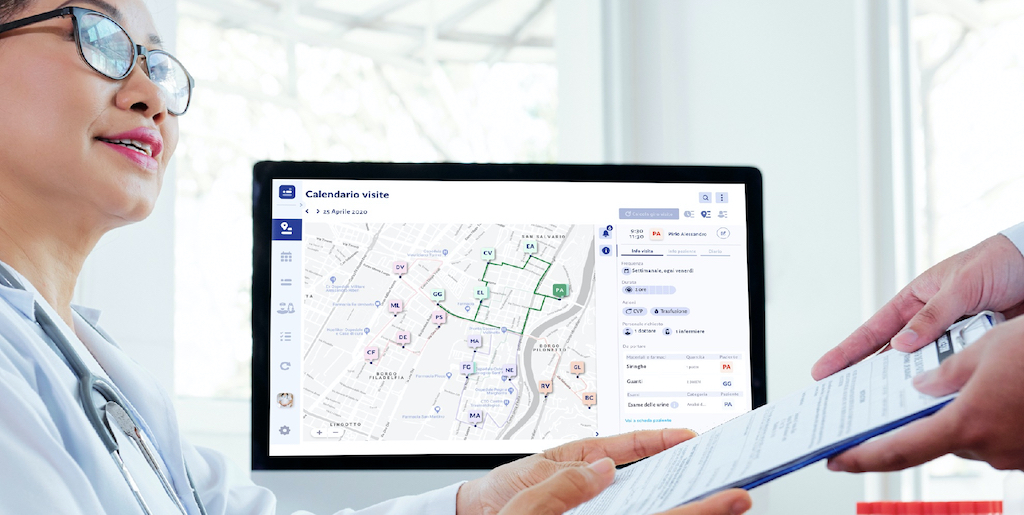
GoCare: Interactive dashboard for a better home hospitalization service CANP European Research Project Share In the context of the European research project CaNP* (“Casa Nel Parco”), Experientia conducted qualitative interviews, shadowing activities and participatory workshops to identify weaknesses and opportunities to improve the home hospitalization service of Molinette di Torino. Based on this research, the GoCare interactive dashboard was designed and validated. (* application 320-12 with co-financing of POR FESR Piemonte 2014-2020) 3 things to know Easier and faster visit management GoCare helps healthcare professionals to significantly reduce time spent on planning the schedule of visits, by analyzing and cross-referencing the relevant data – including patient priority and complexity, geolocation, and the healthcare staff’s shift. Improved communication between stakeholders Communication between caregivers and medical staff is facilitated through simultaneous access to a shared information center with visit schedules and patient monitoring. Data driven decision making The platform provides digital assistance and data to make daily decisions, just a click away. Gallery In depth Service mix: Prototyping Information architecture Participatory design Service design User experience testing Ethnography Context In the context of the European research project CaNP (“Casa Nel Parco”), Experientia conducted qualitative interviews, shadowing activities and participatory workshops to identify weaknesses and opportunities to improve the home hospitalization service of Molinette di Torino. Based on this research, the GoCare interactive dashboard was designed and validated. The prototype facilitates the planning of healthcare staff visits to patients’ homes, improves communication between staff, patients, and healthcare professionals, and manages contingencies, and better use of resources. The GoCare prototype of the CANP European research project (Question 320-12) was created thanks to the co-financing of the POR FESR Piemonte 2014-2020. It was implemented in the context of the Piedmont FESR 2014/2020 Regional Operational Program, in particular the “Health and Wellness” Technological Platform. functional technologies for the implementation of s3 strategies (Call Code: I.1b.2.2) Challenge Home hospitalization services offer an alternative to traditional hospitalization for patients in the acute phase of the disease. Active in Piedmont, since 1985 at AO CSST, it is dedicated to patients with geriatric and metabolic bone diseases. Experientia has designed a digital platform with the aim of facilitating the planning of visits by healthcare professionals to patients’ homes, improving communication between staff, patients and healthcare professionals, optimizing the management of contingencies and the use of resources. Research Experientia conducted interviews and analysis of the tasks within the OAD of Molinette and Cresla of Novara. The interviews provided useful details and requirements. Case studies on the best practices of similar services on a global scale, digital platforms, information structure and visual design were also researched. Critical points and opportunities emerged from the analysis. Design The conception phase subsequently allowed to develop a concept of a digital platform. This concept was designed, starting from the analysis and evaluation of activity flows, user paths and the creation of a detailed service model. Starting from the hi-fi wireframe screen design of the digital platform, the Experientia team created a design system and a visual reference (visual UI) and developed a click-through prototype, iterating based on the initial feedback received from the experts. Impact A study conducted by the University of Turin estimated that, if the platform were implemented in the current OAD department of the Molinette hospital, healthcare personnel would save up to 90-120 minutes a day used today to plan daily visits and 180 minutes per day today used to update paper documents. Related projects All Services Behavioral design Research and assessment Strategy Health Rare disease patient journey mapping HealthSocial innovation Singapore: a city for people aging gracefully FinanceHealth XME Salute: integrating insurance offerings with wellness and health practices Go back to our portfolio

